QoS Provisioning Techniques for Future Fiber-Wireless (FiWi) Access Networks
Abstract
:1. Introduction
2. Optical Access-Metro Networks
2.1. Enabling Optical Technologies
Resilient Packet Ring (RPR)
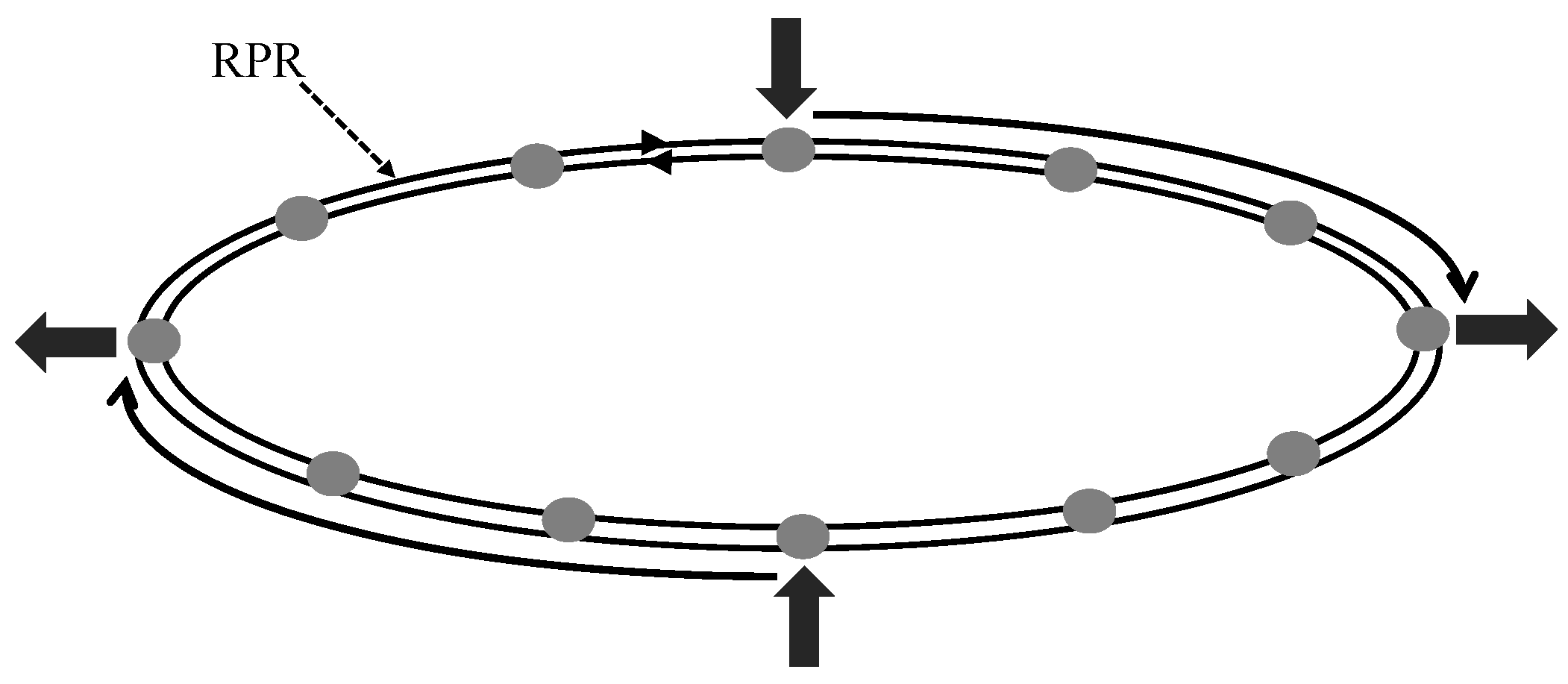
Ethernet Passive Optical Network (EPON)

2.2. Optical QoS Provisioning Techniques and Mechanisms
Traffic Classes
Scheduling and Resource Management
- Direct (single-level) scheduling: allows the OLT to perform both inter-ONU and intra-ONU scheduling [13]. In this approach, a scheduler located in the OLT receives information from and individually schedules each queue located in the ONUs. As the information about each queue is collected in one place, the centralized scheduler can easily ensure that the required service guarantees are preserved and that the excess bandwidth is fairly divided among backlogged queues. The OLT can generate multiple grants, each for a specific traffic class, to be sent to the ONUs using GATE messages [14]. Using a unique logical link identifier (LLID) for each queue allocated by the scheduler eliminates any need for low-level schedulers or ingress shapers in the ONU and gathers all the intelligence in the OLT.
- Hierarchical (multi-level) scheduling: allows the OLT to perform inter-ONU scheduling while each ONU performs intra-ONU scheduling [13]. In this scheme, each ONU requests the OLT to allocate bandwidth based on its buffer occupancy status. The OLT only allocates the requested bandwidth to each ONU while it has no information about the internal queue structure of each ONU. Each ONU divides the allocated bandwidth among its different service classes based on their QoS requirements and schedules the transmissions of different priority queues within the allocated transmission window. In the hierarchical EPON scheduling scheme, the OLT receives a single REPORT message from each ONU and sends a single GATE message to each one. As a result, this scheme is scalable with the number of queues.
- Two-stage buffers (tandem queue at ONU): in this scheme, a priority queue and a single first-in first-out (FIFO) queue are deployed in the first and second stage, respectively. At a given time slot, each ONU transmits traffic from the second stage, while the first stage forwards traffic to the second stage in a priority order. At the end of each time slot, the ONU reports the current occupancy of the second stage buffer to the OLT [13]. Although this scheme eliminates the light-load penalty problem, two-stage buffers increase delay for higher priority classes, i.e., EF traffic.
- Credit-based slot size: in this method, the ONU predicts the amount of high-priority packets that are expected to arrive. The prediction is done for constant bitrate (CBR) flows (i.e., EF traffic), where the intra-ONU scheduler increases the size of requested bandwidth in its REPORT message based on the statistical history of previous cycles [14].
3. Wireless Access-Metro Networks
3.1. Enabling Wireless Technologies
Long Term Evolution (LTE)
- Carrier aggregation, where multiple fixed bandwidth carriers are aggregated to support huge transmission bandwidth with very high transmission rates, e.g., the 20 MHz carriers are aggregated to a bandwidth of up to 100 MHz.
- Relaying support, to increase coverage and decrease deployment cost.
- Extended multi-antenna transmission, to increase the number of downlink/uplink transmissions which enlarges the total transmission rate.
- Coordinated multipoint (CoMP) transmission/reception, where multiple cells perform transmission/reception simultaneously to improve the performance of cell-edge nodes.
- Backward compatibility, where both first LTE released end-users and LTE-Advanced end-users are able to access the network, thereby providing a cost-efficient pay-as-you-grow migration.
WiMAX
WiFi
- A-MSDU: Aggregate MAC service data unit (A-MSDU) is used to join multiple MSDU subframes (see Fig. 3(a)). Specifically, a high-throughput (HT) wireless station (STA) packs multiple MSDUs with possibly different destination addresses into one MAC protocol data unit (MPDU) and sends it to the HT access point (AP). An HT AP is allowed to pack multiple MSDUs into one MPDU, whereby all constituent MSDU subframes must be destined to the same HT STA. In either direction, all constituent MSDU subframes must have the same traffic identifier (TID) value (i.e., same QoS level).
- A-MPDU: Aggregate MAC protocol data unit (A-MPDU) is used to join multiple MPDU subframes (see Fig. 3(b)). Specifically, multiple MPDUs with the same receiver address are packed into one PHY service data unit (PSDU).

3.2. Wireless QoS Provisioning Techniques and Mechanisms
Traffic Classes
- Unsolicited grant service (UGS): it provides fixed-size interval transmission opportunities without the need for requests or grants.
- Real-time polling service (rtPS): it allows the BS to offer periodic request opportunities to a specific SS in order to indicate its required bandwidth.
- Extended-real-time polling service (ErtPS): it is able to offer unsolicited unicast grants, similarly to UGS, and to change the size of the bandwidth grant dynamically.
- Non-real-time polling service (nrtPS): it provides fairness by means of allocating the contention and regular unicast request opportunities in the uplink bandwidth request (UL-request) of each SS. Unicast request opportunities are offered regularly in order to ensure that the SS has a chance to request bandwidth even in a congested network environment.
- BE: it is based on contention and provides non-regular unicast request opportunities.
Scheduling and Resource Management
4. QoS Provisioning Techniques for Future FiWi Networks
4.1. Enabling FiWi Technologies
4.2. FiWi Architectures

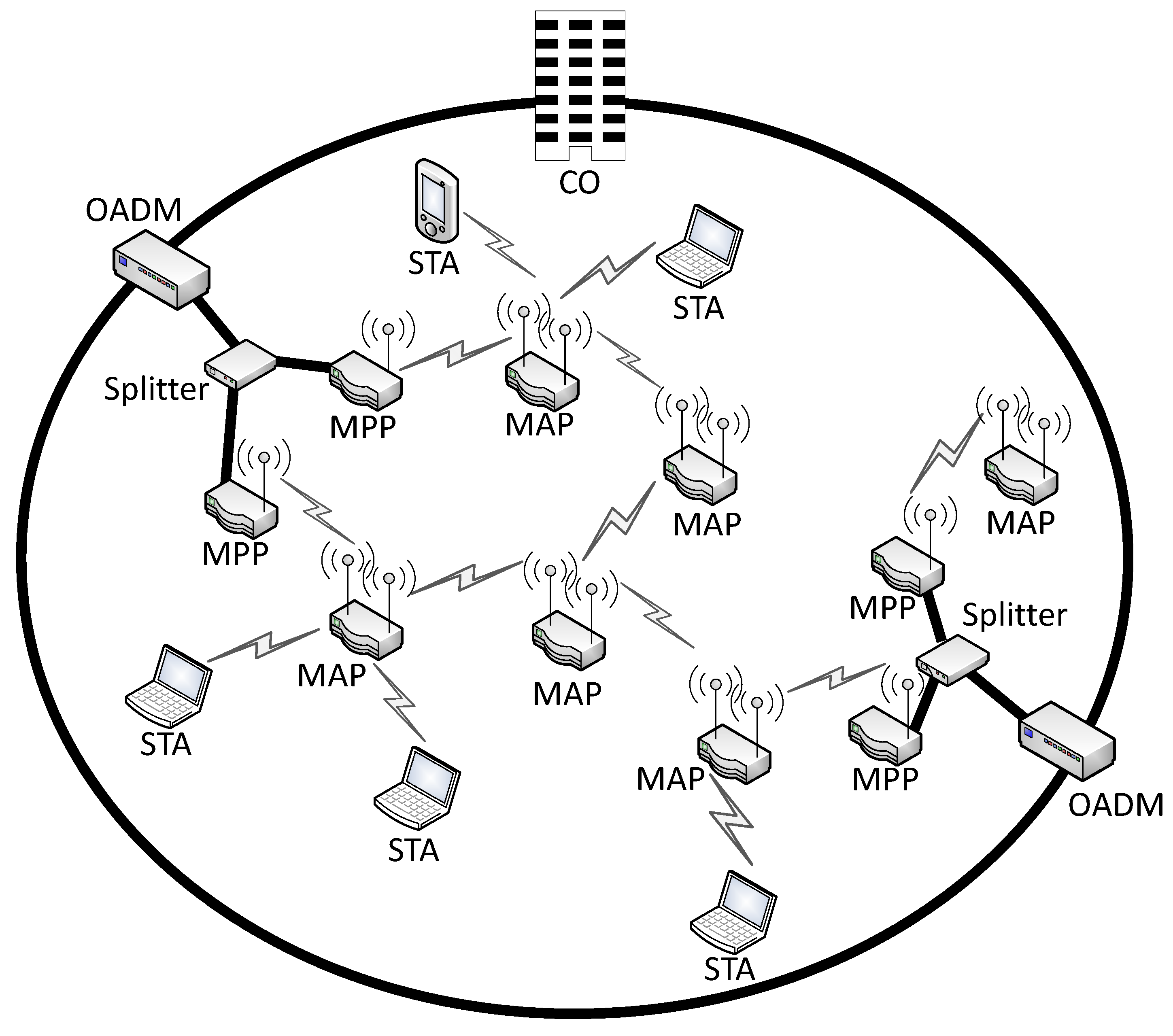
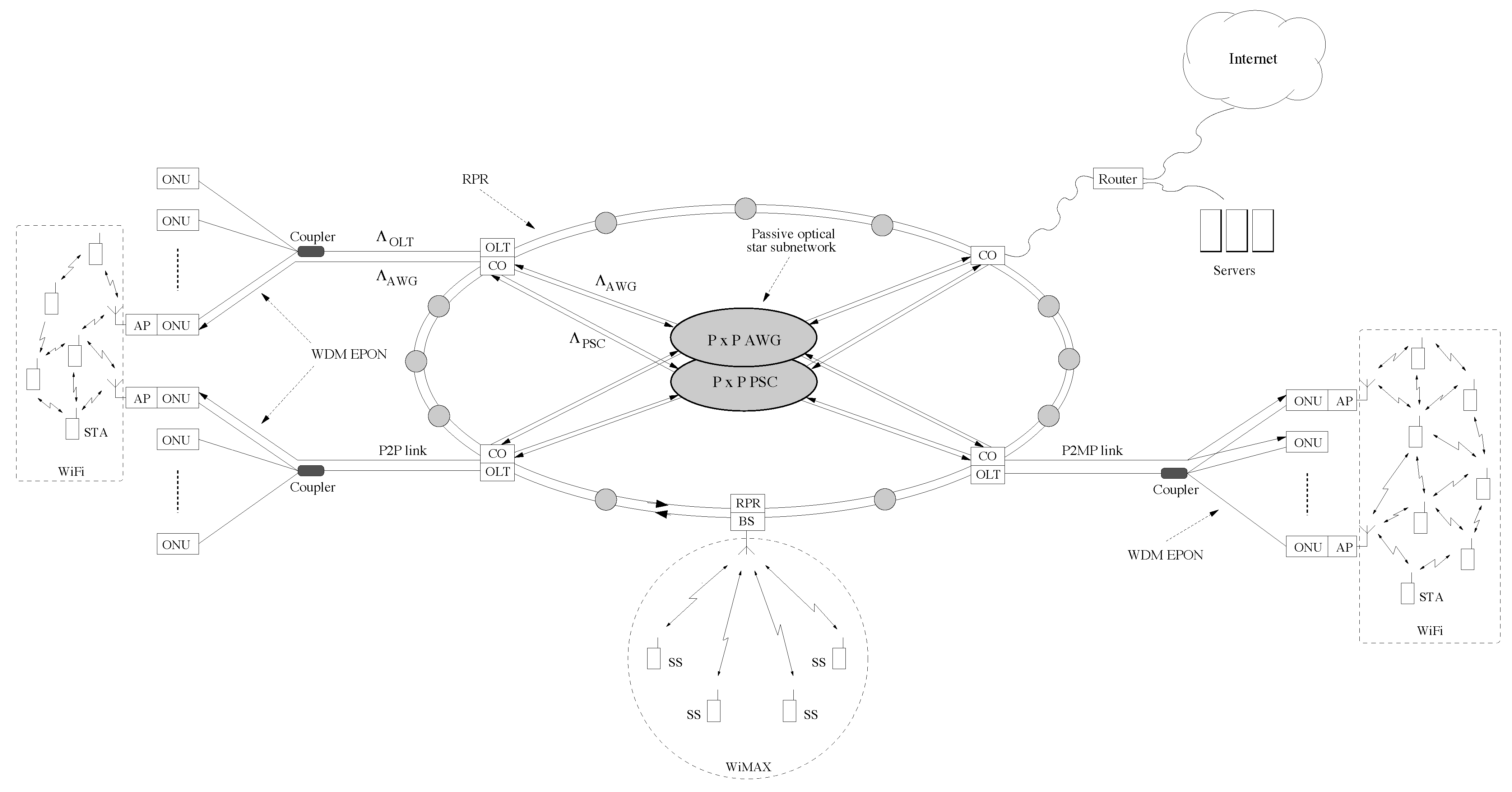
4.3. FiWi QoS Provisioning Techniques and Mechanisms
Traffic Class Mapping, Scheduling, and Resource Management
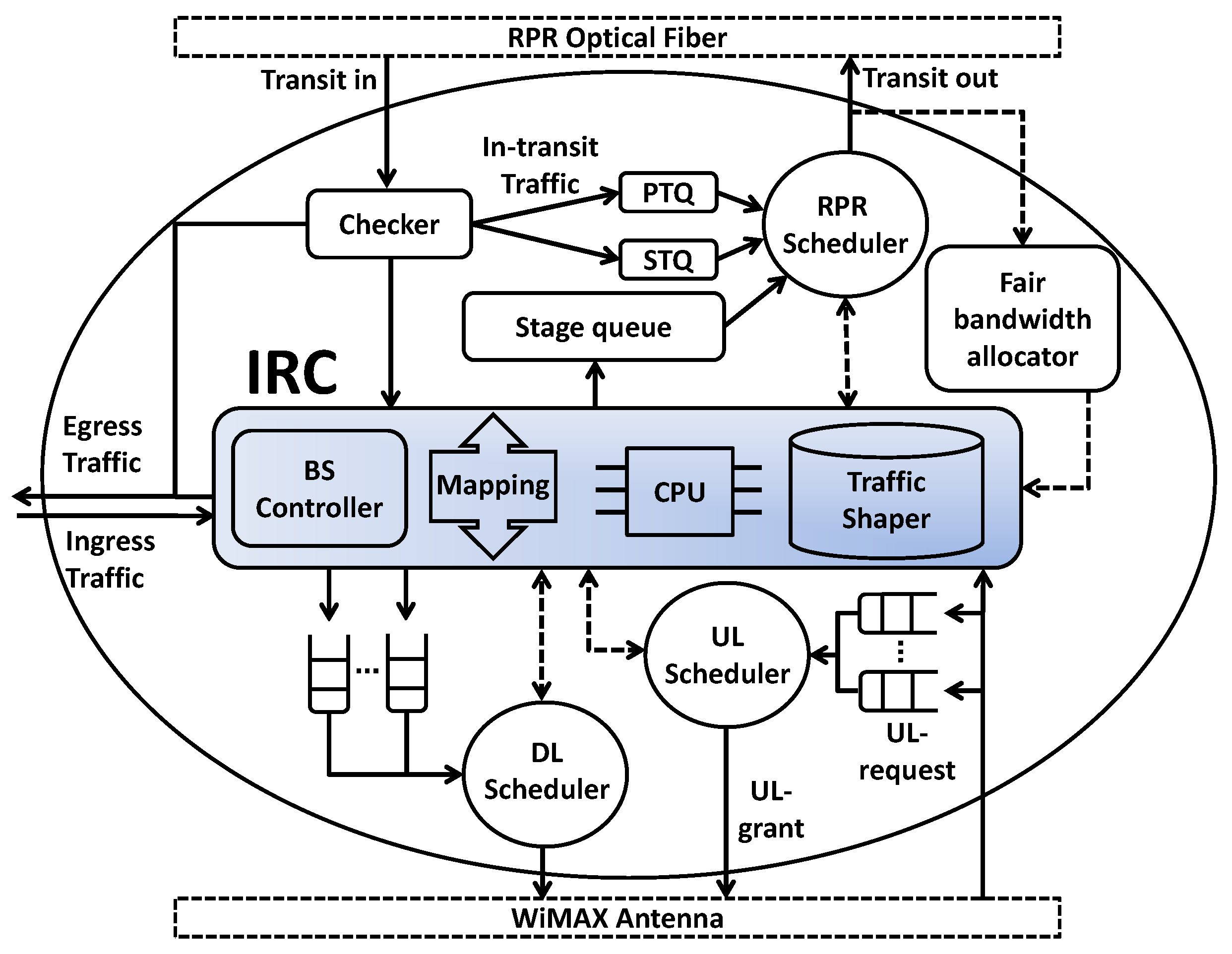

| RPR Traffic Classes | WiMAX Scheduling Services | Applications |
|---|---|---|
| A0: Low latency and jitter, pre-allocated reserved bandwidth | UGS: Unsolicited grant service, reserved fixed-size grants | Real-time fixed-size data packets on a periodic basis, without silence suppression (VoIP, T1, and E1 voice service) |
| A1: Low latency and jitter, pre-allocated unreserved reclaimable bandwidth | ErtPS: Extended real-time, efficiency of both UGS and rtPS polling service, dynamic size allocations | Delay-sensitive real-time flows, variable-size data packets on a periodic basis (VoIP with activity detection) |
| B-CIR: Committed information rate, predictable latency and jitter, pre-allocated unreserved reclaimable bandwidth | rtPS: Real-time polling service, real-time unicast request opportunities | Real-time flows of variable-size data packets on a periodic basis (streaming audio-video, MPEG) |
| B-EIR: Excess information rate, predictable latency and jitter, unallocated unreserved bandwidth | nrtPS: Non real-time polling service, unicast assurance polling on a regular basis | Delay tolerant data services with a minimum required data rate (FTP) |
| C: Unpredictable latency and jitter, unallocated unreserved bandwidth | BE: Best-effort service | Delay and jitter tolerant data services (Web browsing, E-mail, data transfer) |
- FIFO: Typically, UGS SFs consist of fixed-size packets at a constant data rate. FIFO queuing is used for UGS SFs due to its ability to provide in-order packet queuing for high-priority packets.
- Adaptive DRR: To schedule ertPS, rtPS, and nrtPS SFs, an adaptive deficit round robin (DRR) scheduler is used to satisfy both delay and fairness performance of real-time traffic. The adaptive scheduler operates according to the traffic status, i.e., non-burst mode or burst mode.
- RR: Due to the delay insensitivity of BE SFs, a simple round robin (RR) scheduler is applied for scheduling them.
- DFPQ: This scheduling scheme is deployed in order to improve the fairness between the outputs of the adaptive DRR and RR schedulers. Deficit fair priority queuing (DFPQ) arranges the SF queues according to their priority classes. It then calculates the quantum of each non-empty queue based on the required bandwidth in a scheduling cycle. The higher priority packets are scheduled first, until the deficit counter of their traffic classes become smaller than a pre-selected threshold. Subsequently, lower priority packets are scheduled.
- PQ: Priority queuing (PQ) is applied to distinct traffic classes with various QoS requirements. The straightforward slot allocation of PQ is suitable for higher priority queues. PQ is used at the outputs of the FIFO and DFPQ schedulers in order to provide service differentiation of higher and lower priority SFs.
Aggregation Techniques
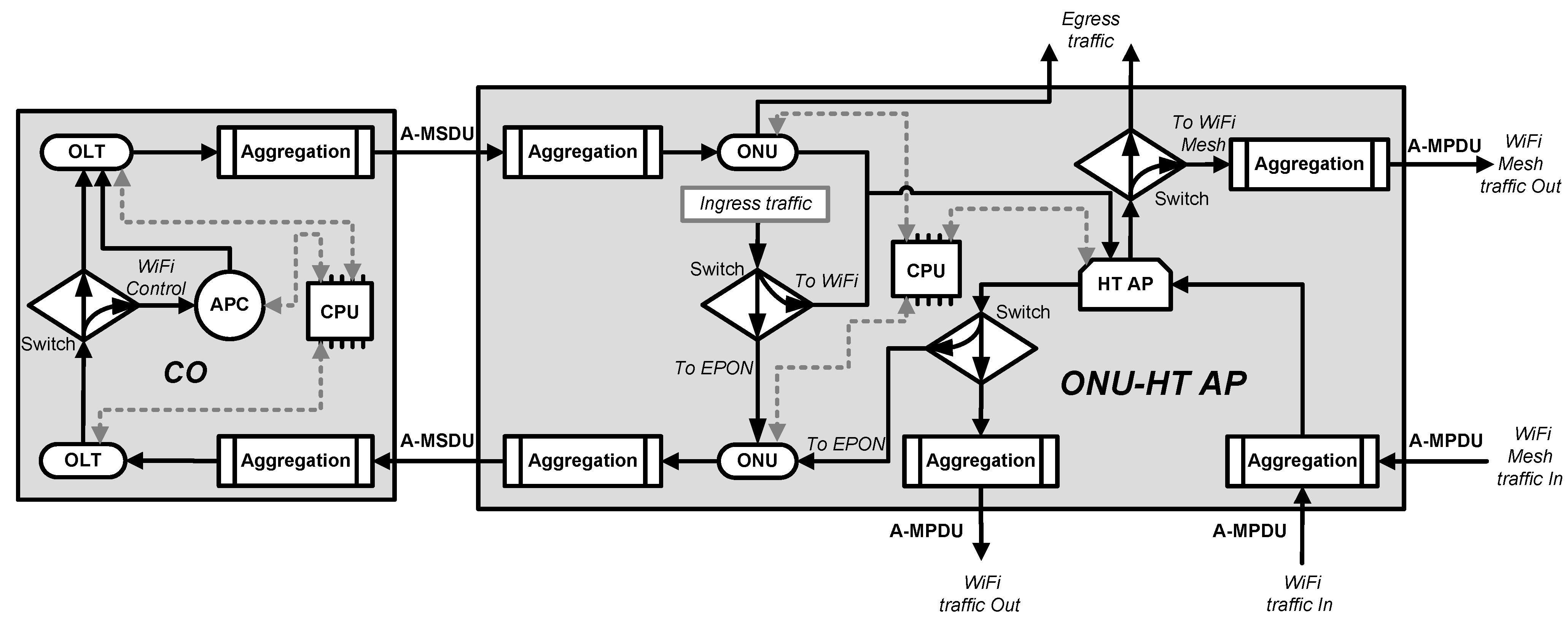
Congestion Control and Layer-2 Path Selection Algorithms
5. Numerical Results
5.1. Integration of RPR and WiMAX
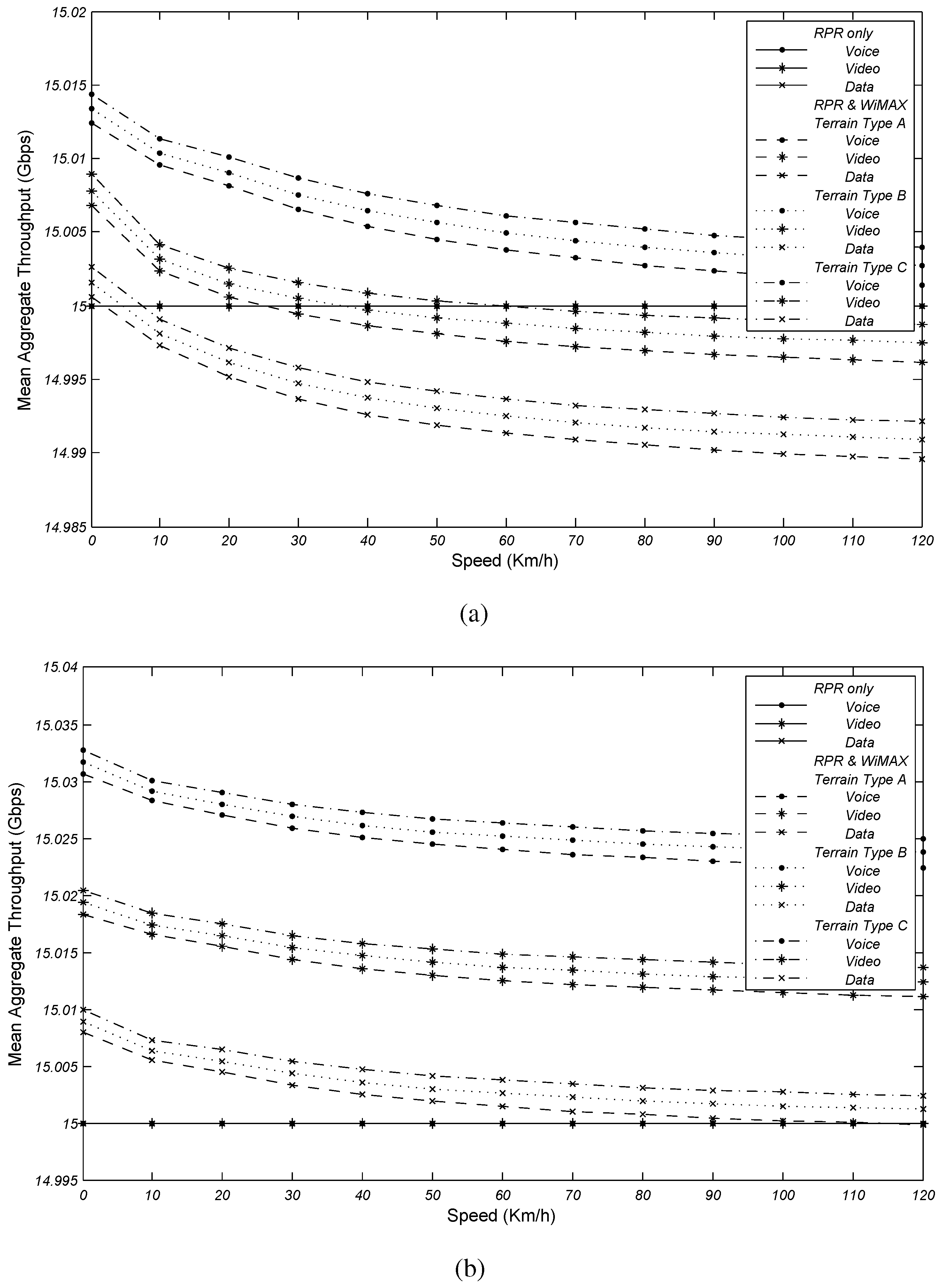
5.2. Integration of EPON and WLAN
Advanced Aggregation Techniques
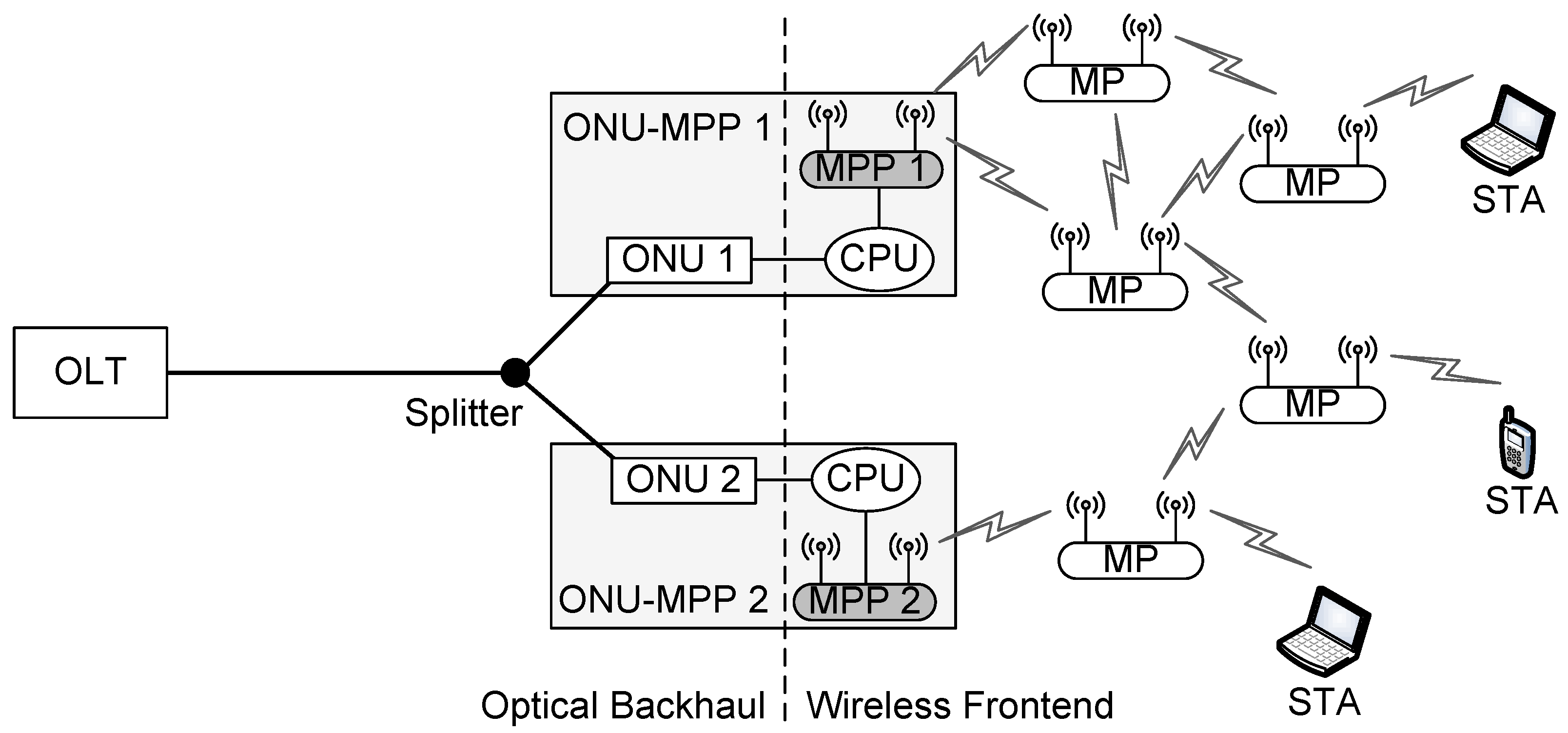

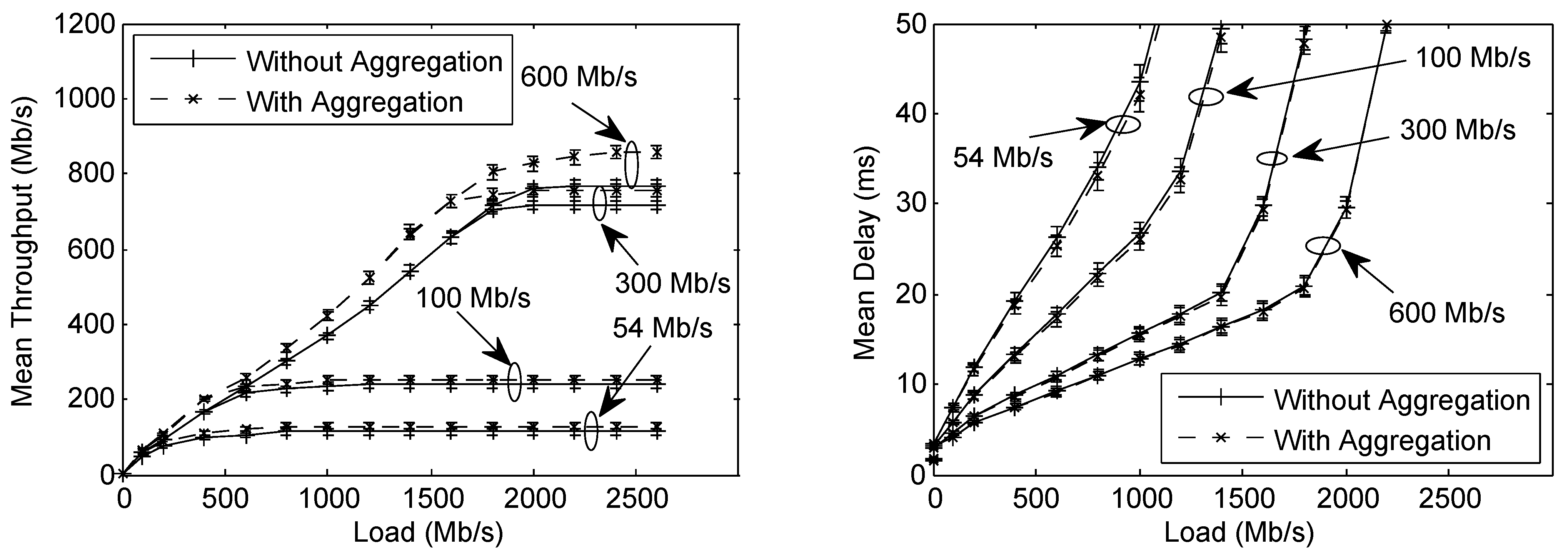
Integrated Path Selection Scheme
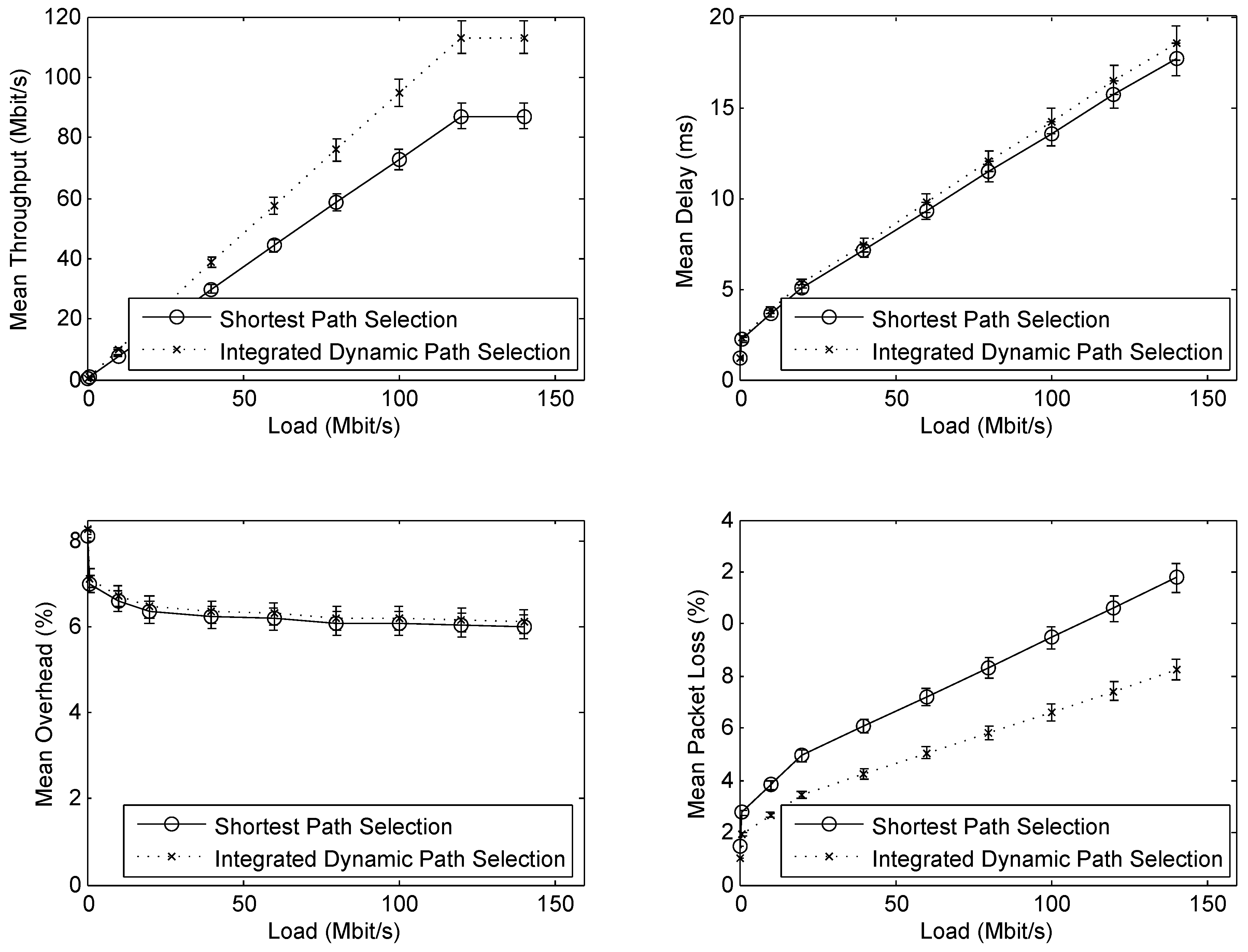
6. Conclusions
References
- Koonen, T. Fiber to the Home/Fiber to the Premises: What, Where, and When. Proceedings of the IEEE 2006, 94, 911–934. [Google Scholar] [CrossRef]
- Maier, M.; Ghazisaidi, N.; Reisslein, M. The Audacity of Fiber-Wireless (FiWi) Networks (Invited Paper). In Proceedings of the ICST ACCESSNETS, Las Vegas, NV, USA; 2008; pp. 1–10. [Google Scholar]
- MacLeod, J.; Safavian, S.R. FMC: Fixed-Mobile Convergence. Bechtel Technology Journal 2008, 1, 57–75. [Google Scholar]
- Ghazisaidi, N.; Maier, M. Fiber-Wireless (FiWi) Networks: Challenges and Opportunities. IEEE Network. to appear. [CrossRef]
- Kim, J.; Um, T.-W.; Ryu, W.; Lee, B.S. Heterogeneous Networks and Terminal-Aware QoS/QoE-Guaranteed Mobile IPTV Service. IEEE Communications Magazine 2008, 46, 110–117. [Google Scholar] [CrossRef]
- Park, S.; Jeong, S.-H. Mobile IPTV: Approaches, Challenges, Standards, and QoS Support. IEEE Internet Computing 2009, 13, 23–31. [Google Scholar] [CrossRef]
- Davik, F.; Yilmaz, M.; Gjessing, S.; Uzun, N. IEEE 802.17 Resilient Packet Ring Tutorial. IEEE Communications Magazine 2004, 42, 112–118. [Google Scholar] [CrossRef]
- Yuan, P.; Gambiroza, V.; Knightly, E. The IEEE 802.17 Media Access Protocol for High-Speed Metropolitan-Area Resilient Packet Rings. IEEE Network 2004, 18, 8–15. [Google Scholar] [CrossRef]
- Kvalbein, A.; Gjessing, S. Analysis and Improved Performance of RPR Protection. In Proceedings of the IEEE International Conference on Networks (ICON), Singapore; 2004; pp. 119–124. [Google Scholar]
- McGarry, M.P.; Reisslein, M.; Maier, M. Ethernet Passive Optical Network Architectures and Dynamic Bandwidth Allocation Algorithms. IEEE Communications Surveys & Tutorials 2008, 10, 46–60. [Google Scholar]
- IEEE 802.1D, IEEE Standard for Local and Metropolitan Area Networks.
- Zheng, J.; Mouftah, H.T. Media Access Control for Ethernet Passive Optical Networks: An Overview. IEEE Communications Magazine 2005, 43, 145–150. [Google Scholar] [CrossRef]
- Kramer, G. Ethernet Passive Optical Networks. McGraw-Hill, Inc., 2005. [Google Scholar]
- Assi, C.; Ye, Y.; Dixit, S.; Ali, M. Dynamic Bandwidth Allocation for Quality-of-Service Over Ethernet PONs. IEEE Journal on Selected Areas in Communications 2003, 21, 1467–1477. [Google Scholar] [CrossRef]
- Kramer, G.; Mukherjee, B.; Ye, Y.; Dixit, S.; Hirth, R. Supporting Differentiated Classes of Service in Ethernet Passive Optical Networks. Journal of Optical Networking 2002, 1, 280298. [Google Scholar]
- Luo, Y.; Ansari, N. Bandwidth Allocation For Multiservice Access on EPONs. IEEE Communications Magazine 2005, 43, S16–S21. [Google Scholar]
- Astely, D.; Dahlman, E.; Furuskar, A.; Jading, Y.; Lindstrom, M.; Parkvall, S. LTE: The Evolution of Mobile Broadband. IEEE Communications Magazine 2009, 47, 44–51. [Google Scholar] [CrossRef]
- 3GPP TR 36.913, Requirements for Further Advancements for Evolved-Universal Terrestrial Radio Access (E-UTRA).
- International Telecommunication Union-Recommendation (ITU-R), M.1645.
- Kuran, M.S.; Tugcu, T. A Survey on Emerging Broadband Wireless Access Technologies. Computer Networks 2007, 51, 3013–3046. [Google Scholar] [CrossRef]
- Li, B.; Qin, Y.; Low, C.P.; Gwee, C.L. A Survey on Mobile WiMAX. IEEE Communications Magazine 2007, 45, 70–75. [Google Scholar] [CrossRef]
- IEEE P802.11n, Draft 5.0, Part 11: Wireless LAN Medium Access Control (MAC) and Physical Layer (PHY) Specifications: Enhancements for Higher Throughput. 2008.
- Skordoulis, D.; Ni, Q.; Chen, H.; Stephens, A.P.; Liu, C.; Jamalipour, A. IEEE 802.11n MAC Frame Aggregation Mechanisms for Next-Generation High-Throughput WLANs. IEEE Wireless Communications 2008, 15, 40–47. [Google Scholar] [CrossRef]
- Lin, Y.; Wong, V.W.S. Frame Aggregation and Optimal Frame Size Adaptation for IEEE 802.11n WLANs. In Proceedings of the IEEE GLOBECOM, San Francisco, CA, USA; 2006; pp. 1–6. [Google Scholar]
- Hiertz, G.R.; Zang, Y.; Max, S.; Junge, T.; Weiss, E.; Wolz, B. IEEE 802.11s: WLAN Mesh Standardization and High Performance Extensions. IEEE Network 2008, 22, 12–19. [Google Scholar] [CrossRef]
- Bahr, M. IEEE P802.11 Wireless LANs: Resolution to CID 1736 - HWMP Overview. IEEE P802.11 - TASK GROUP S 2009, 1–3. [Google Scholar]
- Wang, X.; Lim, A.O. IEEE 802.11s Wireless Mesh Networks: Framework and Challenges. Ad Hoc Networks 2008, 6, 970–984. [Google Scholar] [CrossRef]
- Faccin, S.M.; Wijting, C.; Kenckt, J.; Damle, A. Mesh WLAN Networks: Concept and System Design. IEEE Wireless Communications 2006, 13, 10–17. [Google Scholar] [CrossRef]
- Camp, J.D.; Knightly, E.W. The IEEE 802.11s Extended Service Set Mesh Networking Standard. IEEE Communications Magazine 2008, 46, 120–126. [Google Scholar] [CrossRef]
- He, T.; Chan, S.-H.G.; Wong, C.-F. HomeMesh: A Low-Cost Indoor Wireless Mesh for Home Networking. IEEE Communications Magazine 2008, 46, 79–85. [Google Scholar] [CrossRef]
- Ishmael, J.; Bury, S.; Pezaros, D.; Race, N. Deploying Rural Community Wireless Mesh Networks. IEEE Internet Computing 2008, 12, 22–29. [Google Scholar] [CrossRef]
- Garroppo, R. G.; Giordano, S.; Iacono, D.; Tavanti, L. Notes on Implementing a IEEE 802.11s Mesh Point. In Proceedings of the EuroNGI Workshop, Barcelona, Spain, 2008; pp. 60–72.
- Larmo, A.; Lindstrom, M.; Meyer, M.; Pelletier, G.; Torsner, J.; Wiemann, H. The LTE Link-Layer Design. IEEE Communications Magazine 2009, 47, 52–59. [Google Scholar] [CrossRef]
- Ni, Q. Performance Analysis and Enhancements for IEEE 802.11e Wireless Networks. IEEE Network 2005, 19, 21–27. [Google Scholar]
- Anas, M.; Rosa, C.; Calabrese, F.D.; Pedersen, K.I.; Mogensen, P.E. Combined Admission Control and Scheduling for QoS Differentiation in LTE Uplink. In IEEE Vehicular Technology Conference, Calgary, AB, Canada, 2008; pp. 1–5.
- Kwan, R.; Leung, C.; Zhang, J. Proportional Fair Multiuser Scheduling in LTE. IEEE Signal Processing Letters 2009, 16, 461–464. [Google Scholar] [CrossRef]
- Mongha, G.; Pedersen, K.I.; Kovacs, I.Z.; Mogensen, P.E. QoS Oriented Time and Frequency Domain Packet Schedulers for The UTRAN Long Term Evolution. In Proceedings of the IEEE Vehicular Technology Conference (VTC), Marina Bay, Singapore, 2008; pp. 2532–2536.
- Cicconetti, C.; Lenzini, L.; Mingozzi, E.; Eklund, C. Quality of Service Support in IEEE 802.16 Networks. IEEE Network 2006, 20, 50–55. [Google Scholar] [CrossRef]
- Jia, Z.; Yu, J.; Ellinas, G.; Chang, G.-K. Key Enabling Technologies for Optical-Wireless Networks: Optical Millimeter-Wave Generation, Wavelength Reuse, and Architecture. IEEE/OSA Journal of Lightwave Technology 2007, 25, 3452–3471. [Google Scholar] [CrossRef]
- Perez, J.; Morant, M.; Llorente, R.; Marti, J. Joint Distribution of Polarization-Multiplexed UWB and WiMAX Radio in PON. IEEE/OSA Journal of Lightwave Technology 2009, 27, 1912–1919. [Google Scholar] [CrossRef]
- Kazovsky, L.G.; Shaw, W.-T.; Gutierrez, D.; Cheng, N.; Wong, S.-W. Next-Generation Optical Access Networks. IEEE/OSA Journal of Lightwave Technology 2007, 25, 3428–3442. [Google Scholar] [CrossRef]
- Ghazisaidi, N.; Maier, M.; Assi, C.M. Fiber-Wireless (FiWi) Access Networks: A Survey. IEEE Communications Magazine 2009, 47, 160–167. [Google Scholar] [CrossRef]
- Lannoo, B.; Colle, D.; Pickavet, M.; Demeester, P. Radio-over-Fiber-Based Solution to Provide Broadband Internet Access to Train Passengers. IEEE Communications Magazine 2007, 45, 56–62. [Google Scholar] [CrossRef]
- Pleros, N.; Vyrsokinos, K.; Tsagkaris, K.; Tselikas, N.D. A 60 GHz Radio-Over-Fiber Network Architecture for Seamless Communication With High Mobility. IEEE/OSA Journal of Lightwave Technology 2009, 27, 1957–1967. [Google Scholar] [CrossRef]
- Shen, G.; Tucker, R.S.; Chae, C.-J. Fixed Mobile Convergence Architectures for Broadband Access: Integration of EPON and WiMAX. IEEE Communications Magazine 2007, 45, 44–50. [Google Scholar] [CrossRef]
- Shaw, W.-T.; Wong, S.-W.; Cheng, N.; Zhu, X.; Maier, M.; Kazovsky, L.G. Hybrid Architecture and Integrated Routing in a Scalable Optical-Wireless Network. IEEE/OSA Journal of Lightwave Technology 2007, 25, 3443–3451. [Google Scholar] [CrossRef]
- Ghazisaidi, N.; Maier, M. Fiber-Wireless (FiWi) Networks: A Comparative Techno-Economic Analysis of EPON and WiMAX. In Proceedings of the IEEE Global Communications Conference (GLOBECOM), Honolulu, HI, USA, 2009; pp. 1–6.
- Maier, M.; Herzog, M.; Reisslein, M. STARGATE: The Next Evolutionary Step Toward Unleashing the Potential of WDM EPONs. IEEE Communications Magazine 2007, 45, 50–56. [Google Scholar] [CrossRef]
- McGarry, M.P.; Maier, M.; Reisslein, M. WDM Ethernet Passive Optical Networks. IEEE Communications Magazine 2006, 44, S18–S25. [Google Scholar] [CrossRef]
- Luo, Y.; Yi, S.; Wang, T.; Suemura, Y.; Nakamura, S.; Ansari, N.; Cvijetic, M. QoS-Aware Scheduling over Hybrid Optical Wireless Networks. In Proceedings of the Optical Fiber Communication Conference and Exposition/National Fiber Optic Engineers Conference (OFC/NFOEC), Anaheim, CA, USA, 2007; pp. 1–7.
- Yang, K.; Ou, S.; Guild, K.; Chen, H.-H. Convergence of Ethernet PON and IEEE 802.16 Broadband Access Networks and its QoS-Aware Dynamic Bandwidth Allocation Scheme. IEEE Journal on Selected Areas in Communications 2009, 27, 101–116. [Google Scholar] [CrossRef]
- Ghazisaidi, N.; Paolucci, F.; Maier, M. SuperMAN: Optical-Wireless Integration of RPR and WiMAX. OSA Journal of Optical Networking 2009, 8, 249–271. [Google Scholar] [CrossRef]
- Ghazisaidi, N.; Maier, M. Advanced Aggregation Techniques for Integrated Next-Generation WLAN and EPON Networks. In Proceedings of the IEEE Consumer Communications & Networking Conference (CCNC), Las Vegas, NV, USA, 2010; pp. 1–5.
- Shaw, W.-T.; Wong, S.-W.; Cheng, N.; Balasubramanian, K.; Qiao, C.; Yen, S.-H.; Kazovsky, L.G. Reconfigurable Optical Backhaul and Integrated Routing Algorithm for Load Balancing in Hybrid Optical-Wireless Access Networks. In Proceedings of the IEEE International Conference on Communications (ICC), Beijing, China, 2008; pp. 5697–5701.
- Sarkar, S.; Dixit, S.; Mukherjee, B. Hybrid Wireless-Optical Broadband-Access Network (WOBAN): A Review of Relevant Challenges. IEEE/OSA Journal of Lightwave Technology, Special Issue on Convergence of Optical and Wireless Access Networks 2007, 25, 3329–3340. [Google Scholar] [CrossRef]
- Kramer, G.; Mukherjee, B.; Pesavento, G. IPACT: A Dynamic Protocol for an Ethernet PON (EPON). IEEE Communications Magazine 2002, 40, 74–80. [Google Scholar] [CrossRef]
© 2010 by the authors; licensee MDPI, Basel, Switzerland. This article is an open-access article distributed under the terms and conditions of the Creative Commons Attribution license http://creativecommons.org/licenses/by/3.0/.
Share and Cite
Maier, M.; Ghazisaidi, N. QoS Provisioning Techniques for Future Fiber-Wireless (FiWi) Access Networks. Future Internet 2010, 2, 126-155. https://doi.org/10.3390/fi2020126
Maier M, Ghazisaidi N. QoS Provisioning Techniques for Future Fiber-Wireless (FiWi) Access Networks. Future Internet. 2010; 2(2):126-155. https://doi.org/10.3390/fi2020126
Chicago/Turabian StyleMaier, Martin, and Navid Ghazisaidi. 2010. "QoS Provisioning Techniques for Future Fiber-Wireless (FiWi) Access Networks" Future Internet 2, no. 2: 126-155. https://doi.org/10.3390/fi2020126
APA StyleMaier, M., & Ghazisaidi, N. (2010). QoS Provisioning Techniques for Future Fiber-Wireless (FiWi) Access Networks. Future Internet, 2(2), 126-155. https://doi.org/10.3390/fi2020126




